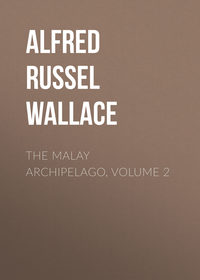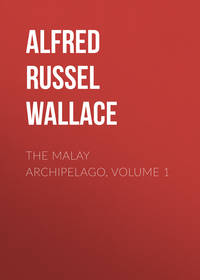 полная версия
полная версияContributions to the Theory of Natural Selection
Buildings of various races do not change, 213.
Buprestidæ, resembling bird’s dung, 57;
similar colours in two sexes, 114.
Butterflies, value of, in studying “natural selection,” 131;
varieties of, in Sardinia and Isle of Man, 178.
CACIA anthriboides, 94.
Callizona acesta, protective colouring of, 59.
Calornis, 239.
Capitonidæ, sexual colouring and nidification of, 241.
Capnolymma stygium, 94.
Carabidæ, special protection among, 72;
similar colouring of two sexes, 114.
Cassidæ, resemble dew drops, 58.
Caterpillars, mimicking a poisonous snake, 99;
gaudy colours of, 117;
various modes of protection of, 118;
gooseberry caterpillar, 119;
Mr. Jenner Weir’s observations on, 119;
Mr. A. G. Butler’s observations on, 121.
Celebes, local modifications of form in, 170;
probable cause of these, 176;
remarkable zoological peculiarities of, 195-199.
Centropus, sexual colouring and nidification of, 242.
Cephalodonta spinipes, 92.
Ceroxylus laceratus, imitates a moss-covered stick, 64.
Certhiola, sexual colouring and nidification of, 244.
Cethosia æole, 172;
biblis, 172.
Cetoniadæ, how protected, 73;
similar colours of two sexes, 114.
Ceycopsis, 196.
Charis melipona, 96.
Chematobia, wintry colours of this genus, 62.
Chlamys pilula, resembles dung of caterpillars, 58.
Chrysididæ, how protected, 72.
Chrysomelidæ, similar colouring of two sexes, 114.
Cicindela, adaptive colour of various species of, 57.
Cilix compressa, resembles bird’s dung, 63.
Cladobates, mimicking squirrels, 107.
Classification, form of true, 6;
circular, inadmissible, 8;
quinarian and circular, of Swainson, 46;
argument from, against Mr. Darwin, 295.
Climacteris, sexual colouring and nidification of, 243.
Coccinellidæ, how protected, 72;
similar colouring of sexes, 114.
Coexisting varieties, 159.
Collyrodes lacordairei, 95.
Colour, in animals, popular theories of, 47;
frequent variations of, in domesticated animals, 48;
influenced by need of concealment, 49;
in deserts, 49, 50;
in Arctic regions, 50, 51;
nocturnal, 51;
tropical, 52;
special modifications of, 52;
different distribution of, in butterflies and moths, 58;
of autumnal and winter moths, 62;
white, generally dangerous and therefore eliminated, 66;
why it exists so abundantly although often injurious, 69;
influenced by need of protection, 113;
of female birds, 114;
in relation to nidification of birds, 116;
gaudy colours of many caterpillars, 117;
in nature, general causes of, 126;
local variations of, 173;
sexual differences of, in birds, 239;
in female birds, how connected with their nidification, 240, 246;
more variable than structure or habits, and therefore more easily modified, 249;
of flowers, as explained by Mr. Darwin, 262;
often correlated with disease, 316.
Compsognathus, 300.
Condylodera tricondyloides, 97.
Consciousness, origin of, 360;
Professor Tyndall on, 361;
not a product of complex organization, 365.
Correlation of growth, 310.
Corynomalus sp., 92.
Cotingidæ, sexual colouring and nidification of, 244.
Cratosomus, a hard weevil, 94.
Crickets mimicking sand wasps, 98.
Cryptodontia, 299.
Cucullia verbasci, 120.
Curculionidæ, often protected by hard covering, 120;
similar colours of two sexes, 114.
Cuviera squamata, 258.
Cyclopeplus batesii, 92.
Cynopithecus, 196.
Cynthia arsinoë, 172.
Danaidæ, the subjects of mimicry, 85, 86.
Danais erippus, 88;
chysippus, 112;
sobrina, 179;
aglaia, 179;
tytia, 180.
Darwin, Mr., his principle of utility, 47;
on cause of colour in flowers, 127, 262;
on colours of caterpillars, 118;
on sexual colouration, 260;
his metaphors liable to misconception, 269;
criticism of, in North British Review, 291.
Desert animals, colours of, 49, 50.
Diadema, species of, mimic Danaidæ, 86, 87;
female with male colouration, 112.
Diadema misippus, 112;
D. anomala, 113.
Diaphora mendica, 89.
Dicnyodontia, 299.
Dicrourus, 253.
Diloba cœruleocephala, 120.
Dimorphism, 145;
in beetles, 155;
in birds, 155;
illustrated, 157.
Dinosauria, 298.
Diptera mimicking wasps and bees, 97.
Doliops curculionides, 94.
Domesticated animals, their essential difference from wild ones, 38-41.
Dotterell, 251.
Drusilla, mimicked by three genera, 181.
Drusilla bioculata, 180.
Dytiscus, dimorphism in, 155.
Egyptian architecture, introduced, 225.
Elaps fulvius, E. corallinus, E. lemniscatus, 101;
E. mipartitus, E. lemniscatus, E. hemiprichii, 102.
Enodes, 196.
Ennomus, autumnal colours of this genus, 62.
Eos fuscata, dimorphism of, 155.
Equus, 299.
Eronia tritæa, 172;
valeria, 172.
Eroschema poweri, 93.
Erycinidæ mimic Heliconidæ, 84.
Erythroplatis corallifer, 92.
Estrelda, sexual colouring and nidification of, 243.
Eucnemidæ, mimicking a Malacoderm, 93.
Eudromias morinellus, 251.
Euglossa dimidiata, 98.
Eumorphidæ, a protected group 72;
imitated by Longicorns, 92.
Euplœa, local modifications of colour in, 173.
Euplœa midamus, 87-113, 179;
E. rhadamanthus, 87, 179.
Eurhinia megalonice, 172;
polynice, 172.
Eurylæmidæ, sexual colouring and nidification of, 243.
Extinct animals, intermediate forms of, 298.
Extinction of lower races, 318.
Female birds, colours of, 114;
sometimes connected with their mode of nidification, 240;
more exposed to enemies than the males, 248.
Female butterflies generally dull-coloured, 259.
Female insects, mimicry by, 110, 259;
colours of, 113.
Female sex, has no incapacity for as brilliant colouration as the male, 247;
in some groups requires more protection than the male, 258.
Fishes, protective colouring of, 55.
Fissirostral birds, nests of, 238.
Flowers, causes of colour in, 127.
Flycatchers, genera of, absent from Celebes, 177.
Forbes, Edward, objections to his theory of Polarity, 17-23.
Force is probably all Will-force, 366.
Galapagos, 10.
Galton, Mr., on range of intellectual power, 339.
Ganocephala, 298.
Gastropacha querci, protective colour and form of, 62.
Gaudry, M., on fossil mammals of Greece, 299.
Geographical distribution, dependent on geologic changes, 1;
its agreement with law of introduction of new species, 9;
of allied species and groups, 12.
Geological distribution analogous to geographical, 13.
Geology, facts proved by, 2-5.
Giraffe, how it acquired its long neck, 42.
Glæa, autumnal colours of this genus, 62.
Gould, Mr., on sexual plumage of Gray Phalarope, 115;
on incubation by male Dotterell, 115.
Grallina australis, 254.
Green birds almost confined to the tropics, 52.
Gymnocerus cratosomoides, 94.
Gymnocerous capucinus, 96.
Gymnocerous dulcissimus, 55.
Gunther, Dr., on arboreal snakes, 55;
on colouring of snakes, 102.
Gynecia dirce, 59.
Habits, often persistent when use of them has ceased, 234;
of children and savages analogous to those of animals, 235;
if persistent and imitative may be termed hereditary, 235, 236.
Hairy covering of Mammalia, use of, 344;
absence of, in man remarkable, 345;
the want of it felt by savages, 346;
could not have been abolished by natural selection, 348.
Harpagus diodon, 107.
Heiliplus, a hard genus of Curculionidæ, 94.
Heliconidæ, the objects of mimicry, 77;
their secretions, 88;
not attacked by birds, 79;
sometimes mimicked by other Heliconidæ, 85.
Helladotherium, 300.
Hemiptera, protected by bad odour, 72.
Herbert, Rev. W., on song of birds, 221.
Hesperidæ, probable means of protection of, 176.
Hesthesis, longicorns resembling ants, 96.
Hestia leuconoë, 180.
Hewitson, Mr., 131.
Hipparion, 299.
Hippotherium, 299.
Hispidæ, imitated by Longicorns, 92.
Holothuridæ, 258.
Homalocranium semicinctum, 101.
Hooker, Dr., on the value of the “specific term,” 165.
Houses of American and Malay races contrasted, 213.
Huxley, Professor, on “Physical Basis of Life,” 362;
on volition, 368.
Hyænictis, 300.
Hybernia, wintry colours of this genus, 62.
Hymenoptera, large number of, peculiar to Celebes, 196.
Icteridæ, sexual colouring and nidification of, 244.
Icthyopterygia, 298.
Ideopsis daos, 180.
Imitation, the effects of, in man’s works, 212.
Indians, how they travel through trackless forests, 207.
Insects, protective colouring of, 56;
mimicking species of other orders, 97;
senses of, perhaps different from ours, 202, 203.
Instinct, how it may be best studied, 201;
definition of, 203;
in many cases assumed without proof, 205;
if possessed by man, 206;
supposed, of Indians, 207;
supposed to be shown in the construction of birds’ nests, 211.
Intellect of savages compared with that of animals, 341.
Intellectual power, range of, in man, 339.
Iphias glaucippe, 172.
Ithomia, mimicked by Leptalis, 83.
Ithomia ilerdina, mimicked by four groups of Lepidoptera, 84.
Java, relations of, to Sumatra and Borneo, 193.
Jamaica swift altering position of nest, 228.
Jerdon, Mr., on incubation by males in Turnix, 115.
Kallima inachis and Kallima paralekta, wonderful resemblance of, to leaves, 59-61.
Labyrinthodontia, 298, 300.
Lakes as cases of imperfect adaptation, 278.
Laniadæ, sexual colouring and nidification of, 245.
Lamarck’s hypothesis very different from the author’s, 41.
Larentia tripunctaria, 63.
Law which has regulated the introduction of new species, 5;
confirmed by geographical distribution, 9;
high organization of ancient animals consistent with, 14;
of multiplication in geometrical progression, 265;
of limited populations, 265;
of heredity, 266;
of variation, 266;
of change of physical conditions, 266;
of the equilibrium of nature, 266;
as opposed to continual interference, 268.
Laycock, Dr., on law of “unconscious intelligence,” 360.
Leaf Butterfly, appearance and habits of, 59-61.
Lepidoptera, especially subject to variation, 132.
Leptalis, species of mimic Heliconidæ, 82;
gain a protection thereby, 259.
Lester, Mr. J. M., on wood-dove and robin, 53.
Levaillant, on formation of a nest, 224.
Limenitis archippus, 88.
Limenitis limire, 172;
procris, 172.
Lizards refusing certain moths and caterpillars, 121;
devouring bees, 121.
Local forms, 158.
Local variation of form, 169;
of colour, 173;
general remarks on, 174;
in Celebesian butterflies, probable use of, 175.
Locustidæ, adaptive colouring of, 64.
Luminousness of some insects a protection, 71.
Lycænidæ, probable means of protection of, 176.
Mammals, mimicry among, 107.
Man, does he build by reason or imitation, 212;
his works mainly imitative, 225;
antiquity of, 303, 322;
difference of opinion as to his origin, 304;
unity or plurality of species, 305;
persistence of type of, 306;
importance of mental and moral characters, 312;
his dignity and supremacy, 324;
his influence on nature, 326;
his future development, 326;
range of intellectual power in, 339;
rudiments of all the higher faculties in savage, 341;
his feet and hands, difficulties on the theory of natural selection, 349;
his voice, 350;
his mental faculties, 351;
difficulty as to the origin of the moral sense in, 259;
development of, probably directed by a superior intelligence, 359.
Mantidæ, adaptive colouring of, 64;
mimicking white ants, 98.
Malacoderms, a protected group, 93.
Maluridæ, 255.
Matter, the nature of, 363;
Mr. Bayma on, 363;
is force, 365.
Mechanitis and Methona, mimicked by Leptalis, 83.
Mecocerus, dimorphism of, 155.
Mecocerus gazella, 94.
Megacephalon, 196.
Megapodidæ, sexual colouring and nidification of, 246.
Meropogon, 196.
Midas dives, 97.
Mimeta, mimicking Tropidorhynchus, 104.
Mimicry, meaning of the word, 74;
theory of, 76;
among Lepidoptera, 77;
how it acts as a protection, 80, 81;
of other insects by Lepidoptera, 89;
among beetles, 91;
of other insects by beetles, 95;
of insects by species of other orders, 97;
among the vertebrata, 99;
among snakes, 101;
among tree frogs, 103;
among birds, 103;
among mammals, 107;
objections to the theory of, 108;
by female insects, 110;
among Papilionidæ, 179;
never occurs in the male only, 260.
Momotidæ, sexual colouring and nidification of, 241.
Montrouzier, M., on butterflies of Woodlark Island, 152.
Moral sense, difficulty as to the origin of, 352.
Morphos, how protected, 73.
Murray, Mr. Andrew, objections to theory of mimicry, 108.
Muscicapidæ, sexual colouring and nidification of, 245.
Musophagidæ, sexual colouring and nidification of, 242.
Napeogenes, all the species are mimickers, 85.
Natural selection, the principle stated, 41-43;
general acceptance of the theory of, 46;
tabular demonstration of, 302;
outline of theory of, 307;
its effects on man and animals different, 311;
hardly acts among civilized societies, 330;
what it can not do, 333;
cannot produce injurious or useless modifications, 334.
Nectarineidæ, 254.
Necydalidæ, mimic Hymenoptera, 96.
Nemophas grayi, a Longicorn mimicked by a Longicorn, 95.
Nests of Birds, why different, 215;
of young birds, how built, 219;
construction of, described by Levaillant, 224;
imperfections in, 229;
influenced by changed conditions and persistent habits, 232;
classification of, according to function, 237.
New forms, how produced by variation and selection, 286.
New Guinea, relation of the several Papuan islands to, 194.
Nocturnal animals, colours of, 51.
Nomada, 98.
Oberea, species resemble Tenthredinidæ, 96.
Odontocera odyneroides, 96.
Odontocheila, 97.
Odyncrus sinuatus, 90.
Onthophilus sulcatus, like a seed, 58.
Onychocerus scorpio, resembles bark, 56.
Orange-tip butterfly, protective colouring of, 59.
Orchis, structure of an, explained by natural selection, 271.
Orgyia antiqua and O. gonostigma, autumnal colours of, 62.
Oriolidæ, 253.
Ornithoptera priamus, 145, 173;
O. helena, 173.
Oxyrhopus petolarius, O. trigeminus, O. formosus, 102.
Owen, Professor, on more generalized structure of extinct animals, 298.
Pachyotris fabricii, 96.
Pachyrhynchi, weevils mimickedby Longicorns, 95.
Paleotherium, 299.
Paloplotherium, 299.
Papilio, black and red group imitated, 84.
Papilio achates, 147;
P. adamantius, 171;
P. ænigma, 87;
P. agamemnon, 141, 158, 170, 171;
P. agestor, 180;
P. alphenor, 148, 169;
P. amanga, 151;
P. androcles, 171;
P. androgeus, 88, 147, 180, 183;
P. antiphates, 141, 171;
P. antiphus, 87, 150, 170, 180, 183;
P. aristæus, 171;
P. arjuna, 141;
P. ascalaphus, 171;
P. autolycus, 160;
P. bathycles, 141;
P. blumei, 171;
P. brama, 171;
P. caunus, 87, 179;
P. codrus, 160, 171;
P. cöon, 88, 146, 180, 182;
P. deiphobus, 140;
P. deiphontes, 171;
P. delessertii, 180;
P. demolion, 171;
P. diphilus, 87, 170, 180, 183;
P. doubledayi, 88, 180;
P. elyros, 148;
P. encelades, 171;
P. erectheus, 151;
P. euripilus, 160;
P. evemon, 159;
P. gigon, 171;
P. glaucus, 152;
P. hector, 87, 150, 180, 183;
P. helenus, 160, 171;
P. hospiton, 178;
P. idæoides, 180;
P. jason, 159, 171;
P. ledebouria, 148;
P. leucothoë, 171;
P. leodamas, 170;
P. liris, 87, 180, 184;
P. macareus, 179;
P. machaon, 178;
P. melanides, 148, 150;
P. memnon, 88, 140, 146, 147, 152, 180, 183;
P. milon, 171;
P. nephelus, 140;
P. nicanor, 170;
P. œnomaus, 88, 180, 184;
P. onesimus, 151;
P. ormenus, 150, 152, 182;
P. pammon, 147, 152, 170, 180;
P. pamphylus, 171;
P. pandion, 152, 180;
P. paradoxa, 87, 179;
P. peranthus, 160, 171;
P. pertinax, 145;
P. philoxenus, 182;
P. polydorus, 88, 170, 182;
P. polytes, 147, 148;
P. rhesus, 171;
P. romulus, 87, 148, 150, 183;
P. sarpedon, 141, 158, 171;
P. sataspes, 171;
P. severus, 140, 144;
P. theseus, 87, 148, 150, 169, 170, 171, 180, 183;
P. thule, 179;
P. torquatus, 156;
P. turnus, 152;
P. ulysses, 140, 160, 173;
P. varuna, 88.
Papilionidæ, the question of their rank, 133;
peculiar characters possessed by, 134;
peculiarly diurnal, 136;
compared with groups of mammalia, 138;
distribution of, 140;
large forms of Celebes and Moluccas, 168;
large forms of Amboyna, 169;
local variation of form, 169;
arrangement of, 186;
geographical distribution of, 189;
of Indo-Malay and Austro-Malay regions, 192;
of Java, Sumatra, and Borneo, 193.
Paridæ, sexual colouring and nidification of, 243.
Passenger pigeon, cause of its great numbers, 308.
Patent inventions, as illustrating classification, 295.
Phacellocera batesii, mimics one of the Anthribidæ, 94.
Phalaropus fulicarius, 115, 295.
Phasmidæ, imitate sticks and twigs, 64;
females resembling leaves, 112.
Phyllium, wonderful protective colour and form of, 64.
Physalia, 258.
Pieridæ, local modification of form in, 172.
Pieris, females only imitating Heliconidæ, 172.
Pieris coronis, 172;
eperia, 172.
Pieris pyrrha, 113.
Picidæ, sexual colouring and nidification of, 242.
Pipridæ, sexual colouring and nidification of, 245.
Pittidæ, 253.
Pliocerus equalis, 101;
P. elapoides, P. euryzonus, 102.
Pæciloderma terminale, 93.
Polarity, Forbes’ theory of, 17, 45.
Polymorphism, 145;
illustration of, 157.
Population of species, law of, 28;
does not permanently increase, 29;
not determined by abundance of offspring, 29;
checks to, 30;
difference in the case of cats and rabbits explained, 32.
Prevision, a case of, 122.
Prioniturus, 196.
Protection, various modes in which animals obtain it, 69-71, 258;
greater need of, in female insects and birds, 113.
Protective colouring, theory of, 65.
Psittaci (Parrots), sexual colouring and nidification of, 242.
Pterosauria, 298.
Ptychoderes, 94.
RACES, or subspecies, 160;
of man, origin of, 319.
Redbreast and woodpigeon, protective colouring of, 53, 54.
Representative groups, 9;
of Trogons, butterflies, &c., 12.
Reptiles, protective colouring of, 54.
Rhamphastidæ, sexual colouring and nidification of, 242.
Rhinoceros, 299.
River system, as illustrating self-adaptation, 276.
Roses, Mr. Baker on varieties of, 165.
Rudimentary organs, 23.
SALVIN, Mr. Osbert, on a case of bird mimicry, 107.
Saturnia pavonia-minor, protective colouring of larva of, 63.
Satyridæ, probable means of protection of, 176.
Sauropterygia, 299.
Savages, why they become extinct, 319;
undeveloped intellect of, 339, 341;
intellect of, compared with that of animals, 341, 343;
protect their backs from rain, 346.
Scansorial birds, nests of, 238.
Scaphura, 98.
Scissirostrum, 165.
Scopulipedes, brush-legged bees, 91.
Scudder, Mr., on fossil insects, 301.
Scutelleridæ, mimicked by Longicorns, 96.
Sesia bombiliformis, 90.
Sesiidæ, mimic Hymenoptera, 90.
Sexes, comparative importance of, in different classes of animals, 111;
diverse habits of, 156.
Sexual selection, 156;
its normal action to develop colour in both sexes, 247;
among birds, 283.
Sidgwick, Mr. A., on protective colouring of moths, 62.
Simocyonidæ, 300.
Sitta, sexual colouring and nidification of, 243.
Sittella, sexual colouring and nidification of, 243.
Snakes, mimicry among, 101.
Song of birds, instinctive or imitative, 220.
Species, law of population of, 28;
abundance or rarity of, dependent on the adaptation to conditions, 33;
definition of, 141, 161;
the range and constancy of, 143;
extreme variation in, 163, 164.
Speed of animals, limits of, 292.
Sphecia craboniforme, 90.
Sphecomorpha chalybea, 96.
Sphegidæ, mimicked by flies, 97.
Spiders, which mimic ants, 98;
and flower buds, 99.
Spilosoma menthastri, 88.
Stainton, Mr., on moths rejected by turkeys, 78, 88.
Stalachtis, a genus of Erycinidæ, the object of mimicry, 84.
Stinging insects generally conspicuously coloured, 72.
Streptocitta, 196.
Sturnidæ, sexual colouring and nidification of, 244.
Sturnopastor, 239.
St. Helena, 10.
Streptolabis hispoides, 93.
Struggle for existence, 28, 33.
Survival of the fittest, law of, stated, 33;
its action in determining colour, 67.
Swainson’s circular and quinarian theory, 45.
Sylviadæ, sexual colouring and nidification of, 245.
Synapta, 258.
TACHORNIS phœnicobea, 228.
Tachyris hombronii, 172;
ithome, 172;
lycaste, 172;
lyncida, 172;
nephele, 172;
nero, 172;
zarinda, 172.
Tanagridæ, sexual colouring and nidification of, 245.
Tapir, 299.
Telephori, similar colouring of two sexes, 114.
Temperate and cold climates favourable to civilization, 318.
Thecodontia, 299.
Therates, mimicked by Heteromera, 95.
Thyca descombesi, 172;
hyparete, 172;
rosenbergii, 172;
zebuda, 172.
Tiger, adaptive colouring of, 52.
Times newspaper on Natural Selection, 296.
Tools, importance of, to man, 314.
Tree frogs, probable mimicry by, 103.
Tricondyla, 97.
Trimen, Mr., on rank of the Papilionidæ, 136.









